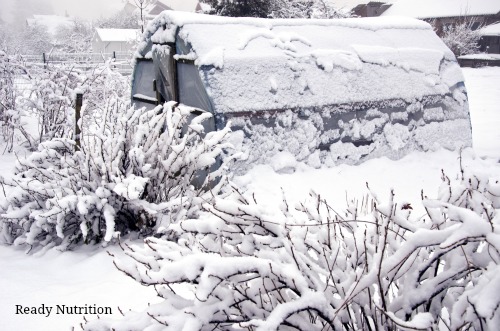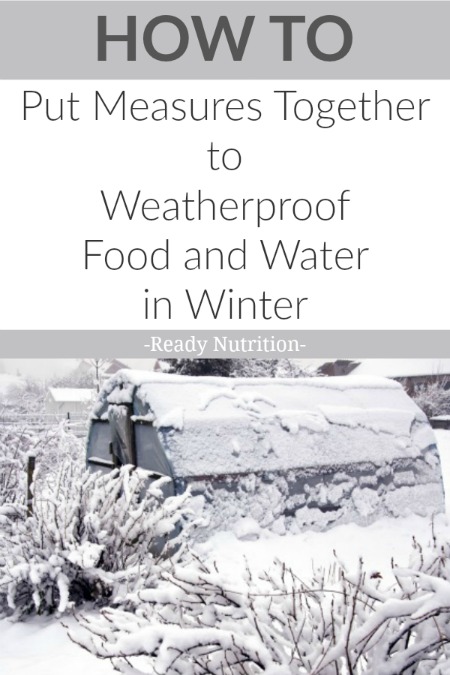
In those articles, I stressed the importance of a thermos during the winter to carry (at a bare minimum) hot water. I recommend the water over coffee for several reasons. First, coffee is a diuretic, and this means that an excessive amount will cause you to lose water through urination. If you drink as much coffee as I do, it is not so much an issue there, as your body will compensate with the increased intake. Secondly and more importantly, you can do more with a thermos of hot water than you can with coffee.
Hot water can be used for soup (think “Vitamin R,” as we called it in the Army or Ramen), and if you are the way I am…you can pack either a jar or a Tupperware container with instant coffee. The hot water is invaluable to restore your core temperature if you need to do so. One thermos is good, and two is even better. Be sure to insulate your thermos, at a bare minimum by wrapping a heavy blanket around it. I have two old sweatshirt sleeves, very thick. The wide part goes over the top and to the bottom, folded, and the other sleeve wide part over the bottom, and up to the top. Voila! Just this little measure extends the heating time/life of the thermos by about 4-6 hours. No, really: it works.
 The other method is with a box. Now, you can go to your thrift store and pick up one on the cheap…a cooler…for a few bucks. Hardly anybody wants a cooler this time of the year. The point: you can place your thermos and food inside of the cooler…and wrap it or “nest” it up in a newspaper, blankets, or what have you. This will insulate your stuff from the cold, plus you have the already-insulated plastic and foam walls of the cooler to serve as a barrier. Whatever the temperature is outside this will give it about a twenty to twenty-five-degree buffer or more.
The other method is with a box. Now, you can go to your thrift store and pick up one on the cheap…a cooler…for a few bucks. Hardly anybody wants a cooler this time of the year. The point: you can place your thermos and food inside of the cooler…and wrap it or “nest” it up in a newspaper, blankets, or what have you. This will insulate your stuff from the cold, plus you have the already-insulated plastic and foam walls of the cooler to serve as a barrier. Whatever the temperature is outside this will give it about a twenty to twenty-five-degree buffer or more.
In a previous article, I wrote about U.S. GI canteens from the Big One (WWII) that are made of steel and will, therefore, be much better to have from a health perspective (to prevent plastics leaching into the water). These guys can stay in their pouches, and this will help protect them from the freeze. Bring them inside with you when you leave the vehicle, or nestle them in your weatherproof box (the former action being the preferred one). If they freeze, then they can be thawed out over the coals of the fire. Be sure to fill them up ¾, to allow for some room if they do freeze.
If you have to pack food with you, pack it in wide-mouthed mason jars to resist a freeze. Cans work too, but you should not allow them to freeze, thaw out, and re-freeze over and over, as it can make your contents be less than palatable. Now, in the event that you’re “crunched,” you can also make a “warm” box with a cardboard box. Preferably two of them if you’re able, with one larger one that the smaller one fits inside with about 4” of space all around, including the bottom. What you’ll then do is crumple up the newspaper and pack it in these gaps, all around, before setting your smaller box inside of the larger one.
You’re duplicating “on the cheap/field expedient manner” with the two boxes what you would be getting if you use the cooler. Then it is just a matter of “nesting” what you want to protect inside of the smaller box, wrapping up those contacts. Insulation. Insulation is the key: to place loft in between your perishable item/item that can be harmed from the cold, and the cold itself. Other items you may need to place inside can be medicines, ointments, oils, beverages, and so forth. When you’re running that engine, yeah, you’re good. What if you can’t run it, though?
If you’ve had an accident, or an accident “has” you, such as an EMP (Electromagnetic Pulse) that suddenly turns your happy Honda Hybrid into a 2,500 lb. paperweight…you’ll need that box to protect your stuff. You’ll need that thermos. Depending on the situation, it may not be possible to get out and start a fire. When traveling, always carry a good supply of throw rags or cheap towels. These can be put to so many uses in insulating stuff that cannot take the cold. Winter is not the time to play around, and you want to give yourself an edge if a situation arises. Please feel welcome to share your own advice on what you have found to work for you, as every little bit helps. JJ out!


Might I suggest that you move to a warmer climate, like Texas. In my 65 years, I have spent more Christmases in shorts than long pants.
TexasScout: Do you really want an influx into TX?
Now that winter is on the way and the desert heat is waning, you have helped me realize I need to keep in my car what I need oi start a fire should I be in town and need to walk 10 miles home. I usually can walk that far, but with a foot injury, I might need to rest more often or even spend the night outdoors. Having hot water already and a way to re-heat if needed is a good idea.
No to Texas, you’all got lots of things that will bite yah, sting yah, and stab yah.